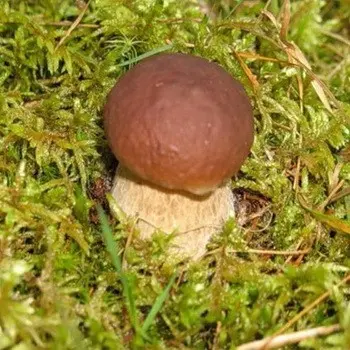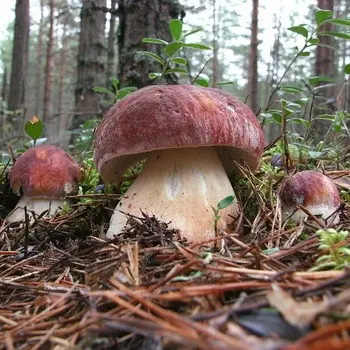Contents
 For lovers of “quiet hunting” autumn is the time when it’s time to go to the forest for mushrooms. Although they begin to grow already in the spring, the autumn mushroom remains the most popular, namely the white one.
For lovers of “quiet hunting” autumn is the time when it’s time to go to the forest for mushrooms. Although they begin to grow already in the spring, the autumn mushroom remains the most popular, namely the white one.
The conditions for the growth of porcini mushrooms have their own specific nuances. Therefore, going to the forest, every mushroom picker should know what kind of weather these fruiting bodies like and what temperature they prefer most of all.
Note that the mycelium of porcini mushrooms grows from early spring to the end of autumn. The growth of the white fungus depends on a constant supply of air, humidity and a certain temperature. The mycelium penetrates the top layer of soil to a depth of 15 cm. If drought or excessive moisture lasts for a long time in the places where the porcini mushroom grows, as well as soil compaction or early frosts, the fruiting bodies develop very poorly and the mycelium dehydrates. Therefore, for good growth of fungi, air humidity and heat are needed, especially in the surface layers.
Humidity and air temperature for the growth of porcini mushrooms after rain
[ »»]
The growth rate of the white fungus will be good only at a relative humidity of up to 60%. If a drought occurs abruptly after the rainy season, the fungus stops growing, even if there is enough moisture in the soil. The fruiting body of the porcini fungus is not protected from evaporation, therefore, at low air humidity, it dries up. Mushroom pickers with extensive experience know that you need to look for porcini mushroom under moss or in the forest floor.
The second important factor influencing the growth of white fungus is the temperature regime, which will also affect the growth of mycelium and the growth of spores. At the same time, it must be said that spores can also grow at low temperatures, for example, at + 8°C.
The optimum air temperature for the growth of porcini mushrooms is from +18 to +28°C. Fruiting bodies grow especially quickly in rainy warm weather; their growth can continue for a whole month. The average weight of the mushroom during this period is up to 250 g. Already on the fourth or fifth day, the average weight of a young mushroom can reach up to 150-180 g. And after the rains, the growth of porcini mushrooms only increases: sometimes mushroom pickers find mushrooms up to 10-12 cm long with large hats with a diameter of up to 15-18 cm.
Mushrooms live (also called white mushrooms) up to 12-14 days. First, the leg stops growing, after 2-3 days and the hat. As soon as spores begin to form, the fruiting bodies of the porcini fungus quickly age.
Places of growth of porcini mushrooms are an important condition for good harvests. These fruiting bodies can grow for several years in a row in one place. However, this condition will depend on how you treat the mycelium itself. Therefore, novice lovers of “silent hunting” should learn – the legs of porcini mushrooms must be carefully cut with a knife, leaving the lower part in the ground so as not to damage the future crop. Next year, while picking mushrooms, you will definitely find mushrooms in the old places.
The growth time of porcini mushrooms depends on the climatic conditions and latitudes in which the forests are located.
[ »wp-content/plugins/include-me/ya1-h2.php»]
Favorite places for growing porcini mushrooms
 These forests are considered the most characteristic landscape for the growth of porcini mushrooms. Such fruiting bodies have a brown cap and stem, prefer sandy or loamy soil. In spruce-fir forests, on moss-lichen litter, boletus mushrooms grow, which mushroom pickers call “a real porcini mushroom.”
These forests are considered the most characteristic landscape for the growth of porcini mushrooms. Such fruiting bodies have a brown cap and stem, prefer sandy or loamy soil. In spruce-fir forests, on moss-lichen litter, boletus mushrooms grow, which mushroom pickers call “a real porcini mushroom.”
Deciduous forests. There are much fewer such forest areas in Our Country than pine ones. However, porcini mushrooms can also be found in them. Birch forests or birch groves are considered a favorite place for the growth of white fungus. The fruiting bodies in these places have a light shade of the cap and stem, as well as a more pleasant taste of the pulp. Prefers borders between overgrown and open areas, as well as edges and well-lit glades.
Mixed forests. Clusters of white mushrooms can often be found in these forests. This may be influenced by the original mixed woodland undergrowth. In addition, birch often grows in them, which can provide a high yield of mushrooms.
The growth sites of porcini mushrooms are common in forest areas throughout the world, except for Antarctica and Australia. As we have seen, they grow in deciduous, pine and mixed forests. These fruiting bodies have conquered almost all of Europe, North and South Africa, Central America, Turkey, China, Japan, Siberia and the Far East. In the forest-steppe zones, the abundance of the growth of porcini mushrooms noticeably decreases, but the boletus completely disappears when moving to the steppe zone.
Knowing the favorite places for the growth of the white fungus and the time of its fruiting, you can safely go into the forest and look for these amazingly tasty and fragrant fruiting bodies. Having found such places, carefully cut off the legs with a knife so as not to damage the mycelium. In subsequent years, you will definitely collect more than one basket here.









